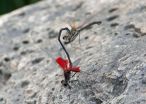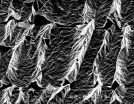(Press-News.org) GAINESVILLE, Fla.-- New genetic data suggest the red lionfish invasion in the Caribbean Basin and Western Atlantic started in multiple locations, not just one as previously believed, according to a new study led by the U.S. Geological Survey.
Florida has often been cited as the likely location of the introduction, but the new research suggests multiple introductions occurred, with some potentially coming from the more southern parts of the range. The Caribbean Basin stretches from parts of Florida's Gulf Coast through South America.
Genetically unraveling the progression of the red lionfish invasion and determining if introductions are still occurring could help guide response and control efforts for this and other invasive fishes. The spiny fish is well known as a predatory invasive species that negatively impacts its non-native environment, disrupting marine food webs as they prey in coral reef ecosystems on invertebrates and fish, including game fish juveniles, such as snappers and groupers. Lionfish are native to the Indo-Pacific region, and were likely brought to the United States via the pet trade.
USGS researchers analyzed red lionfish samples from fourteen countries and territories in the Greater Caribbean and Western Atlantic in an effort to better understand the invasive species' population structure and dispersal patterns. While red lionfish can be found in the Gulf, this study did not include any samples from that region.
"The red lionfish can be used to help up understand other non-native populations and their invasion dynamics," said USGS geneticist Margaret Hunter. "The more we know about this species and its progression, the more we can help resource managers and others fighting the invasion be prepared to help control lionfish colonization in new locations. Ultimately, any information gleaned from this species could be applied to managing and assisting with eliminating future invasive species."
Researchers found that unique regional genetic patterns separated the studied area into northern and southern regions, with the split occurring near the Bahamas. Given the regional genetic differences revealed in this study, the researchers now suspect multiple introductions. One rare genetic strain was found in only a few samples in the southern region, but was pervasive in the north.
"Studying the genetic strains across regions gives us insight into how these fish are spreading. Dispersal against the flow of ocean currents may explain why we see this rare strain in the south, but even if that is the case, additional support for multiple introductions exists; the genetic patterns found in this study support the idea of multiple introductions, and could be due to additional releases in the south," said John Butterfield, a USGS contract biologist and lead author of the publication.
Continued releases would increase the potential for more genetically diverse red lionfish to join the current population, which could counter future removal efforts or allow them to more rapidly expand their range beyond current boundaries.
The broad dispersal of red lionfish may in part be due to their reproductive habits. Females can spawn up to once every four days, which could result in one female releasing up to two million eggs a year. Following spawning, larvae can disperse long distances via ocean currents, for up to 35 days.
In the United States, federal and state agencies are working together to help combat this invasive fish through the Aquatic Nuisance Species Task Force. This intergovernmental entity has drafted a National Invasive Lionfish Prevention and Management Plan that is in the final stages of approval. The main goals of the plan are to prevent the spread of invasive lionfish; coordinate early detection and rapid response efforts; control and management of the current invasive population; and fully assess the impact that the invasion is having on native species and habitats.
INFORMATION:
The full study is available online. More information on USGS Southeast Ecological Science Center's genetics work is available at its genetics website, or on its genetic research fact sheet.
GAINESVILLE, Fla.--Many loggerhead sea turtles that nest in Dry Tortugas National Park head to rich feeding sites in the Bahamas after nesting, a discovery that may help those working to protect this threatened species.
Researchers from the U.S. Geological Survey used satellites to track the population of loggerheads that nest in the Dry Tortugas - the smallest subpopulation of loggerheads in the northwest Atlantic - and found the turtles actually spend a considerable portion of their lives in the Bahamas, returning to the Dry Tortugas to nest every two-to-five years. ...
Why do animals fight with members of other species? A nine-year study by UCLA biologists says the reason often has to do with "obtaining priority access to females" in the area.
The scientists observed and analyzed the behavior of several species of Hetaerina damselflies, also known as rubyspot damselflies. For the study, published this month in the print edition of the journal Proceedings of the Royal Society B, researchers observed more than 100 damselflies a day in their natural habitat along rivers and streams in Texas, Arizona and Mexico.
Male damselflies always ...
As the world's exponentially growing demand for digital data slows the Internet and cell phone communication, City College of New York researchers may have just figured out a new way to increase its speed.
Giovanni Milione, a PhD student under City College Distinguished Professor of Science and Engineering Robert Alfano, led the pioneering experiment conducted at the University of Southern California with collaborators from Corning Incorporated, Scotland, Italy and Canada.
"Conventional methods of data transmission use light which has the fastest speed in the universe. ...
Polymer science will have to add a new giant molecule to its lexicon thanks to a cutting-edge discovery at The University of Akron. Taking a revolutionary "building blocks" approach, researchers have pioneered a way to create a new class of very large polymer molecules, called macromolecules, which assemble themselves into strong, stable structures. The work has been done in collaboration with researchers at Peking University in China and The University of Tokyo in Japan. Their findings have been published in the April 24, 2015 issue of Science magazine.
A team led by ...
We know of about two dozen runaway stars, and have even found one runaway star cluster escaping its galaxy forever. Now, astronomers have spotted 11 runaway galaxies that have been flung out of their homes to wander the void of intergalactic space.
"These galaxies are facing a lonely future, exiled from the galaxy clusters they used to live in," said astronomer Igor Chilingarian (Harvard-Smithsonian Center for Astrophysics/Moscow State University). Chilingarian is the lead author of the study, which is appearing in the journal Science.
An object is a runaway if it's ...
You think that your immune system is there to protect you. But what happens when it starts working against you?
In the earliest stages of cancer formation, the immune system is forced to make a momentous decision. It either activates and suppresses tumor growth to help the body fight disease, or it becomes dysfunctional, helping the tumor grow and making treatment more difficult. Because this tipping point occurs before a person even realizes something is wrong, doctors are unable to directly observe this critical stage.
"We believe that when immune cells enter a tumor ...
WORCESTER, MA - Scientists at the University of Massachusetts Medical School have applied a powerful tool in a new way to characterize genetic variants associated with human disease. The work, published today in Cell, will allow scientists to more easily and efficiently describe genomic variations underlying complex, multi-gene diseases.
"Up to this point, we've only been able to investigate one disease-causing mutation at a time," said principal investigator Marian Walhout, PhD, co-director of the Program in Systems Biology and professor of molecular medicine at UMMS. ...
The oncologists Manuel Hidalgo, Director of the Clinical Research Programme of the Spanish National Cancer Research Centre (CNIO), and Ignacio Garrido-Laguna, member of the Experimental Therapeutics Program at Huntsman Cancer Institute of the University of Utah (USA), have recently published a review of state-of-the-art clinical treatments for pancreatic cancer -- including the most current therapies and innovative research -- in the prestigious scientific journal Nature Reviews Clinical Oncology.
In their study, which reviews around 200 scientific articles published ...
PROVIDENCE, R.I. [Brown University] -- Using a technique that introduces tiny wrinkles into sheets of graphene, researchers from Brown University have developed new textured surfaces for culturing cells in the lab that better mimic the complex surroundings in which cells grow in the body.
"We know that cells are shaped by their surroundings," said Ian Y. Wong, assistant professor of engineering and one of the study's authors. "We've shown that you can make textured environments for cell culture fairly easily using graphene."
Traditionally, cell culture in the lab has ...
An enzyme secreted by the body's fat tissue controls energy levels in the brain, according to new research at Washington University School of Medicine in St. Louis. The findings, in mice, underscore a role for the body's fat tissue in controlling the brain's response to food scarcity, and suggest there is an optimal amount of body fat for maximizing health and longevity.
The study appears April 23 in the journal Cell Metabolism.
"We showed that fat tissue controls brain function in a really interesting way," said senior author Shin-ichiro Imai, MD, PhD, professor of ...


